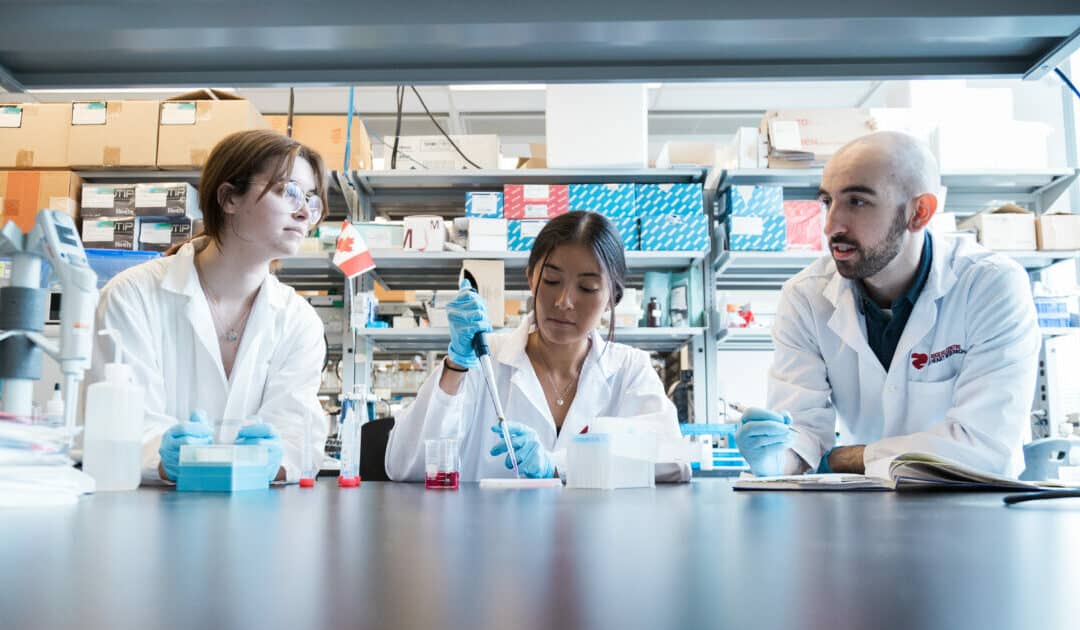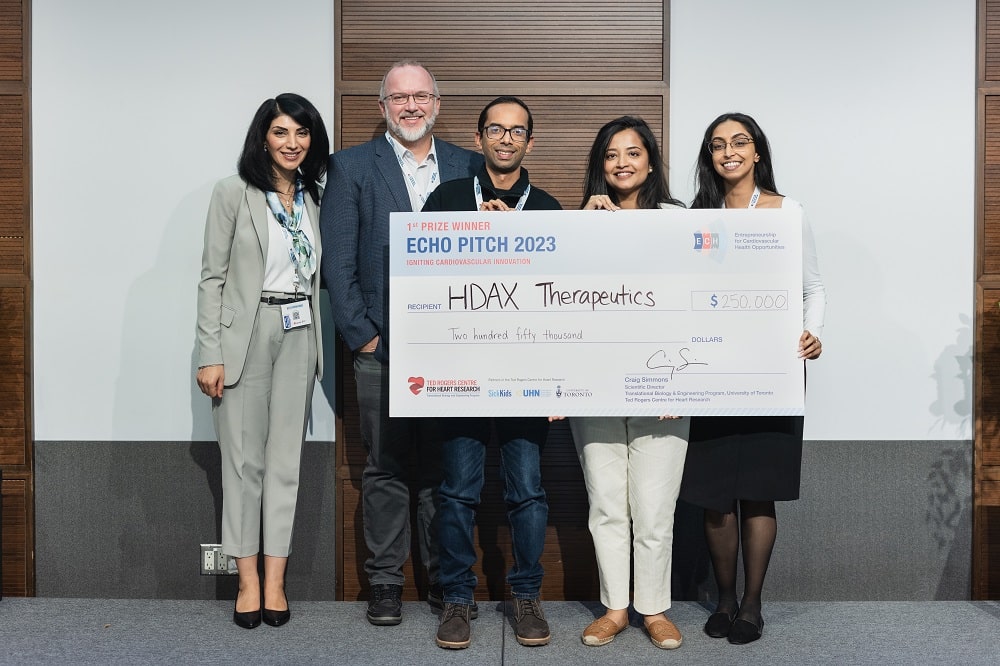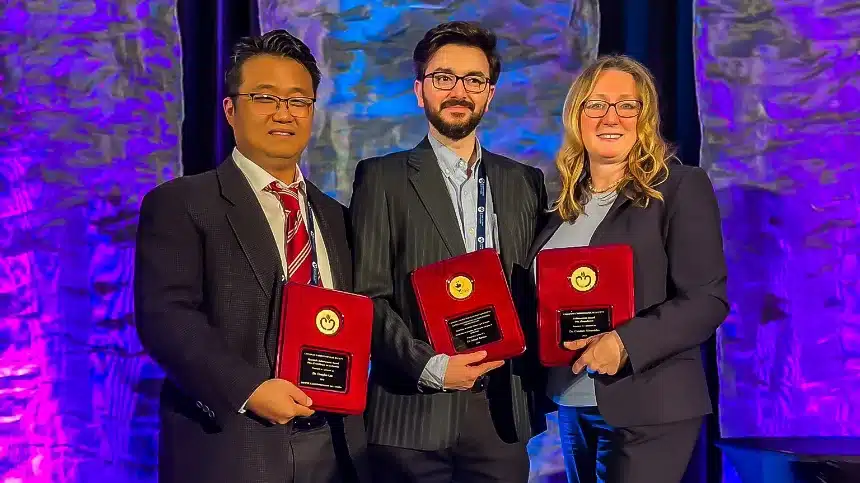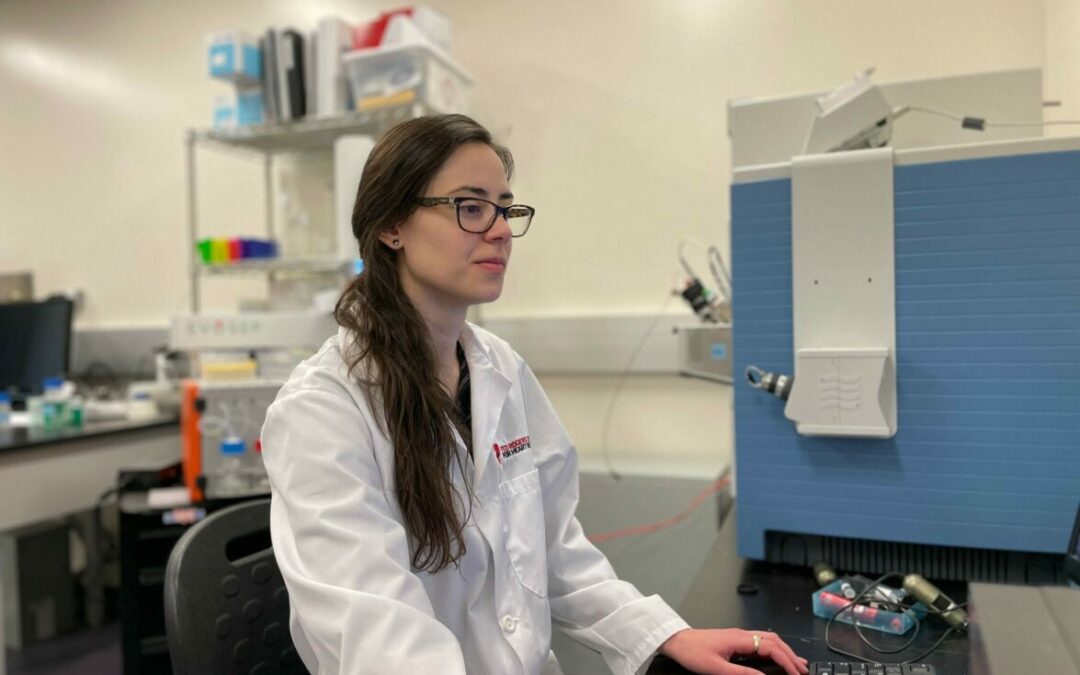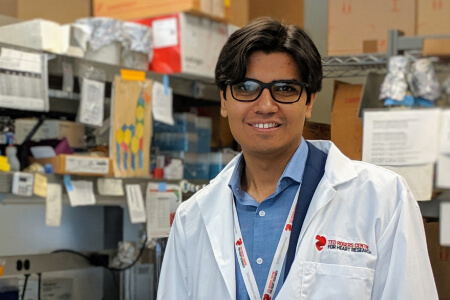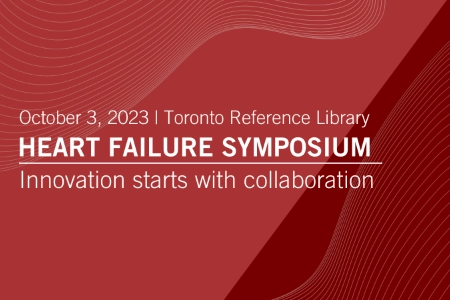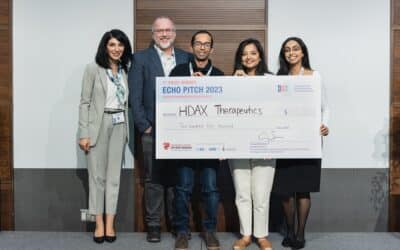Post-Doctoral Fellowship
A novel cardiomyoctye-based device for cardiovascular drug testing
– Yousef Shafieyan (Supervisor: Boris Hinz, U of T)
The accuracy of pre-clinical tests has a dramatic impact on drug development costs and is limited by lack of a contraction assay that quantifies cardiomyocyte force, signal amplitude, and beating rate. We aimed to develop a novel device for high-throughput drug screening applications. By detecting wrinkles in silicone substrates, analysis of cardiomyocyte contraction was achievable. We recorded changes in amplitude and frequency of beating colonies in presence of clinically relevant compounds. The results were in strong correlation with expected outcome and demonstrate that the assay can be transferred to a format compatible with high-throughput imaging systems for pre-clinical drug screenings.
Microfluidics for the discovery of small molecule inhibitors of bacterial endocarditis
– Azad Eshghi (Supervisors: Tara Moriarty, Craig Simmons, U of T)
Bacterial endocarditis is generally fatal if not treated with long-term antibiotic therapy. With increasing prevalence of bacterial antibiotic resistance, it is essential to develop novel antibiotic-complementing and prophylactic treatments for bacterial endocarditis. Current screening studies of bacterial interactions with endothelia are conducted under static conditions, which do not reproduce a key determinant of these interactions: the fluid shear stress associated with blood flow. We are developing 96-well microfluidic screening devices for medium throughput assays under fluid shear stress to identify small molecule compounds inhibiting bacterial attachment to cardiac valve endothelia.
Profiling of signaling cascade changes in heart pathology through phosphoproteomics
– Uros Kuzmanov (Supervisor: Anthony Gramolini, U of T)
Identification of genetic defects that can result in cardiovascular disease (CVD) has revealed only a limited subset of molecular mechanisms of cardiomyopathies that can result in decreased cardiac function and ultimately in heart failure (HF). Our motivation is to understand the changes in the molecular signaling mechanisms of cardiac muscle cells in CVD and HF by identifying alterations in protein phosphorylation events by well-established phosphoproteomic and bioinformatic techniques in mouse models of CVD and clinical samples. We are convinced that elucidation of clinically relevant signaling cascades is key to developing more effective markers and therapeutics.
Control of cardiac growth and energy metabolism by Mule
– Keith Dadson (Supervisors: Phyllis Billia, Vivek Rao, UHN)
Cardiomyocytes are unable to proliferate due to the absence of positive cell cycle regulators. Since the transcription factor c-Myc is a known regulator of proliferation, we modulated c-Myc protein stability in vivo through targeting Mcl-1 ubiquitin ligase E3 (Mule). Using tamoxifen-inducible cardiac-specific Mule knockout mice, we found that Mule deletion elevates c-Myc in the heart leading to spontaneous pathological cardiac hypertrophy and left ventricular dysfunction 1-month post TAM induction. Co-deletion of Mule and c-Myc rescues this phenotype. These data suggest that the regulation of c-Myc activity by Mule is important for the maintenance of normal heart function.
Determinants of inflammation in atherosclerosis, a major cause of heart failure
– Pedro Marques(Supervisors: Sergio Grinstein, SickKids; Myron Cybulsky, UHN)
(Description unavailable)
PhD
High-throughput gap junction function measurement in cardiac diseases
– Jun Liu (Supervisors: Yu Sun, U of T; Robert Hamilton, SickKids)
Life-threatening cardiac arrhythmias often involve abnormalities of gap junction functions. Gap junction, the special intercellular communication channels, determines intercellular diffusion of molecules and current transit from cell to cell. We have developed a robotic system for high-throughput measurement of gap junction diffusion and current conduction velocity. The system performs automated microinjection and calcium wave imaging on patient-derived iPSC cardiomyocytes in 96-well plates. Preliminary testing results of drugs that upregulate and downregulate gap junction functions will be presented. The technology will enable the discovery of new therapeutics for cardiovascular diseases and promise individualized medication for cardiac patients.
Targeted monoclonal antibody therapies to detect and reverse cardiac amyloidosis
– Natalie Galant (Supervisor: Avijit Chakrabartty, UHN)
Transthyretin (TTR) is an abundant serum protein that normally forms soluble, stable homotetrameric complexes. Mutations and unknown pathological conditions can favour TTR tetramer dissociation into non-native monomers which aggregate and accumulate as amyloid throughout the body, particularly in the heart. We have recently developed conformation-specific monoclonal antibodies (mAbs) which can potentially treat cardiac amyloidosis via their ability to recognize and bind to the disease-associated forms of TTR via a cryptotope. We are investigating the mechanism of mAb-mediated fibrillogenesis inhibition using high resolution imaging techniques to help support the use of mAbs to target pathological protein conformations as potentially effective immunotherapies.
LDL transcytosis in the initiation of atherosclerosis: Identifying the mechanisms that link sex and LDL levels to disease progression
Michael Sugiyama (Supervisor: Warren Lee, SMH/UofT; Myron Cybulsky, David Hwang, Gang Zheng, UHN)
(Description unavailable)
The role of ontologically distinct cardiac macrophages in ischemic injury
– Jillian Macklin (Supervisor: Slava Epelman, UHN)
We have done a comprehensive analysis of macrophage (MF) origin and ontogeny, demonstrating that the heart is populated by several distinct cardiac MF subsets: the majority being embryonic MFs (from embryonic and yolk-sac progenitors) and the remainder being adult MFs (from circulating monocytes). We believe MF origin drives MF function and that post-myocardial infarction (MI), adult MFs promote pathologic inflammation that leads to a loss of embryonic MFs and development of heart failure. We are currently using a tamoxifen-induced mouse line (Cx3cr1 CreER Rosa Td/DTR) to deplete embryonic macrophages and perform functional studies (echocardiography, histology).
Reep5 is essential for formation, maintenance, and function of the endoplasmic reticulum in cardiac muscle
– Shin-Haw Lee (Supervisor: Anthony Gramolini, U of T)
The endoplasmic reticulum (ER) is a specialized cellular organ responsible for many functions. Sustained stresses on cardiomyocytes can initiate ER-dependent cellular pathways that ultimately lead to cell death and heart failure. Here, we have identified a novel cardiac membrane protein, REEP5, which is responsible for proper ER formation and function. REEP5 is also involved in the stress responses that directly contribute to heart failure. Elucidation of the role of REEP5 in the heart will be critical to understanding the normal formation of the ER and its contribution to the pathophysiology of heart failure.
Undergraduate/Summer
Proteomics analysis of the overexpression of PMCA4b pre- and post-Heart Failure
– Colin White-Dzuro (Supervisors: Mansoor Husain, UHN; Anthony Gramolini, U of T)
(Description unavailable)
The effects of pregnancy on maternal cardiac structure and function and materno-fetal hemodynamics in women with pre-existing heart disease as assessed by cardiac MRI
Ioana Stochitoiu (Supervisors: Mike Seed, SickKids; Rachel Wald, UHN)
(Description unavailable)
Scholar Awards
Role of Receptor Expression Enhancing Protein 5 (Reep5) in cardiomyocyte response to ER stress and heart failure
Sina Hadipour-Lakmehsari (Supervisor: Anthony Gramolini, U of T; Ian Scott, SickKids)
(Description unavailable)
Preventing congestive heart failure with first trimester HUCPVC treatment after MI
Alexandra Lucato (Supervisors: Clifford Librach, U of T; Ren-Ke Li, UHN)
(Description unavailable)
The Scholar awards were enabled by a donation from Rogers Communications employees.
